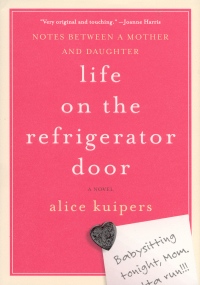| ________________
CM . . .
. Volume XIV Number 6 . . . .November 9, 2007 
 |
Life on the Refrigerator Door: A Novel in Notes.
Alice Kuipers.
Toronto, ON: HarperCollins, 2006.
220 pp., hardcover, $19.95.
ISBN 978-0-00-200679-8.
Grades 8 and up / Ages 13 and up.
Review by Dave Jenkinson.
**** /4
|
| |
|

excerpt:
Good luck with your test today, darling. Sorry I'm not here for breakfast. Twin girls on their way right now.
Peter's cage needs cleaning.
See you tonite.
Love
Mom
– Don't forget your key!
I've gone for a jog by the river, Mom, if you're looking for me. It's a beautiful day and I bet you haven't even had time to notice. Your crocuses are out and so are all those little yellow ones that I forget the name of. They're still all smiling in the sun...
I feel like we haven't talked about anything for weeks. I don't even know what the doctor said to you about treatment stuff. Is everything fine?
My test went OK.
xox
C
In many homes, the refrigerator door functions like a page from a scrapbook album with magnets holding photos, children's artwork, newspaper clippings, grocery lists and other mementoes of family life. For 15-year-old Claire and her 43-year-old divorced, workaholic obstetrician mother, the fridge door becomes a major communication channel as the seeming workaholic mother and her adolescent daughter appear to have limited opportunities for face-to-face conversations. In Life on the Refrigerator Door, first time novelist Alice Kuipers tells her entire story via notes the two leave for each other on the fridge door. The collection of notes are divided into four parts labelled January When I look at you; March I see the woman I want to be; June Strong and brave and September Beautiful and free with a post-Christmas P.S. I love you consisting of two final notes from Claire to her mother. The notes usually rotate between the two writers, but occasionally either Mom or Claire will pen a pair of notes.
In one sense, the book is a very quick read, because, with just a very few exceptions, the notes rarely exceed a full page. Most, in fact, are but a few lines long, and some only a single line, such as Claire's "I'll be at Dad's if you need me" On the other hand, the contents of Life on the Refrigerator Door may cause readers to want or need to reread sections, or, when armed with the knowledge from their first reading, to reread the entire book. Comments in some notes, like "SORRY WE FOUGHT!" indicate that mother and daughter do communicate outside the medium of the fridge notes, and a slower reading and/or a second reading will allow adolescents to speculate on or reconstruct the contents of these unwitnessed conversations.
The plotline is quite simple and, in some ways, predictable. Claire's doctor-mother is diagnosed with cancer and undergoes surgery, radiation and chemotherapy before succumbing to terminal breast cancer. Given her connection to the medical profession and the fact that she has been an independent single mother for six years, Mom initially denies to herself the seriousness of her illness while simultaneously electing to keep the details of her cancer from her daughter. What prevents Life on the Refrigerator Door from becoming just another "dying parent" story is the writing skill Kuipers displays in creating the pair's notes which resonate with authenticity. These written communications between a mother and daughter are filled with the stuff of daily life - a parent's reminders to clean a pet's cage (that of Peter, the rabbit) and to not forget a house key, the requests to pick up groceries, and the passing on of phone messages. The adolescent missives speak to forgotten allowances ("PLEASE PLEASE PLEASE PUT MY ALLOWANCE OUT!!!!"), requests for more money ("Could you leave an extra 20 dollars with my allowance? Pleeeeeeeeaaaaaaaase?" ) and "reasons" for undone or uncompleted tasks ("Sorry I missed you, MOM! I was babysitting and then I went to Emma's to study."). Additionally, the notes reveal how life continues despite a family's member's having a terminal illness. For example, to her mother's ever increasing concern, Claire enters into a relationship with an older guy, Michael. Hopefully readers will pick up on Kuiper's considered use of "salutations" and "complimentary closes" in the notes and will recognize, for instance, the significance of Mom's use of Claire-Bear, her pet name for her daughter, as well as Claire's switch from Mom to Mommy.
The characters also come across as real. At times, Claire is a typical egocentric adolescent who responds to what is happening to her mother only in terms of how the event is impacting her life. "I came home and you WEREN'T HERE, Mom. Nothing strange there then, because you're never home, right?" Mom, on the other hand, has elected to "protect" her adolescent daughter from the hurtful realities of life, a behaviour that began with her divorce. "I didn't want you to ever see that the world can be a bad place, that life is difficult, that sometimes we can't control our destinies." Though Claire and her mother are the novel's principal players, readers are also introduced to a small cast of supporting characters via their inclusion in the refrigerator notes' contents.
Though published as an adult novel, Life on the Refrigerator Door should be a surefire hit with girls, and its contents will be readily accessible to weaker readers.
Highly Recommended.
Dave Jenkinson, who lives in Winnipeg, MB, is CM's editor.

To comment
on this title or this review, send mail to cm@umanitoba.ca.
Copyright © the Manitoba Library Association. Reproduction for personal
use is permitted only if this copyright notice is maintained. Any
other reproduction is prohibited without permission.
NEXT REVIEW |
TABLE OF CONTENTS FOR THIS ISSUE
- November 9, 2007.
AUTHORS |
TITLES |
MEDIA REVIEWS |
PROFILES |
BACK ISSUES |
SEARCH |
CMARCHIVE |
HOME |
